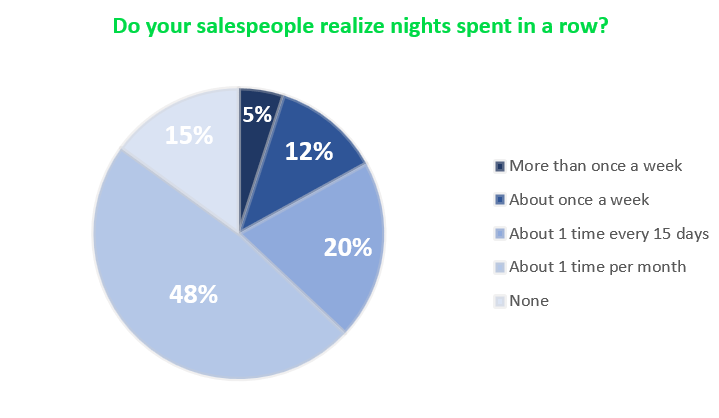Inflation, Olympic Games, AI, Drive... What will impact the field sales force in 2024

Shrinking sales forces?
25% of FMCG manufacturers who responded to Nomadia’s “Field Sales Force”* survey reduced the size of their sales force in 2023 and 12% plan to do so in 2024, in response to the economic difficulties that have led most companies to reduce all their expenses. However, these averages hide significant disparities according to the size of the company. The trend towards a contraction in the field sales force concerns 29% of large companies (turnover of more than €500 million), of which only 7% plan to hire in 2024.
At the other end of the spectrum, 30% of small businesses (turnover of less than €100 million) plan to strengthen their sales force in the next 12 months. This is particularly the case for “small brands” which, after consolidating their regional roots thanks to a differentiating positioning, are seeking to establish themselves on a long-term national scale by recruiting new sector managers (CSs). If they have the wind in their sails, they must remain cautious and, as a result, are only hiring gradually.
Across all company sizes, the prevailing trend is towards stable headcounts: 64% of DNVs do not plan to increase or decrease their sales force in 2024. This stability may mask different realities, such as a decrease in the number of CSs in favor of a greater number of sales promoters, in order to cope with the increase in in-store fulfillment tasks. This is the strategy at work in the largest groups in response to the growing expectations of distributors. Workforce stability can also mask the use of an external sales force for certain product lines, distribution channels or portions of the territory.
Visit plans to be adjusted
Of course, headcount forecasts may be called into question in the coming months in order to adapt to the economic situation, whether it improves or deteriorates, and to take into account the developments, restructuring and consolidation movements underway in the retail sector. DNVs are aware that more than ever, they will have to adjust the calibration of their sales force to occupy the field as efficiently as possible and maximize the profitability of store visits. At the time we interviewed them (October 2023),
- 70% of DNVs planned to visit Casino hypermarkets and supermarkets less in disarray, as the group itself is in the process of being acquired. Can they seriously consider skipping the 313 stores slated to change brands (Auchan and Intermarché) in the coming months? Will the investments that buyers will have to make to bring these stores up to standard make them attractive enough to justify a stronger commercial presence on the part of manufacturers?
- 85% felt they had more leeway in franchised Carrefour stores and 1 in 2 planned to visit them more for this reason. Will they be able to do so with a sales force of the same size, knowing that in 2024 Carrefour plans to switch 37 additional supermarkets and hypermarkets to lease-management, in addition to the 41 sold in 2023, 43 in 2022 and 47 in 2021?
- 27% of DNVs plan to apply a different visit policy for the 60 Cora hypermarkets acquired by Carrefour in July 2023.
- 70% of organizations visit drive-throughs (mainly Leclerc Drive) and 20% plan to visit more in 2024. As the drive-thru market share continues to grow and national brands feature prominently, more DNVs are planning to integrate U Drive and Intermarché Drive into their visit plans, but not Carrefour Drives. It remains to be seen whether these intentions are achievable with a constant or even smaller workforce…
- 62% of respondents visit local circuits, 80% of whom use a dedicated system. While the average size of the teams visiting these circuits is 4 people, in 2/3 of cases it does not exceed 2 people, usually work-study students or apprentices. In 2023, proximity was the main beneficiary of the Rugby World Cup effect. It is reasonable to expect a significant “Olympic Games effect” in 2024 and, to take advantage of this opportunity, to strengthen the presence of field sales representatives in local networks.
The other factor likely to influence visit strategies in 2024 is inflation, even if it tends to stabilize or even lower prices on some UGs. In 2023, it has translated for 60% of sales forces into more statements on the shelves, more promotions and a lot of stickers and instant discount vouchers (BIS).
Better working conditions
Whether or not they plan to hire, 26% of DNVs surveyed face retention issues, with turnover rates above 20%. This phenomenon does not seem to be related to the size of the structure. We are pleased to note that 25% of sales forces have a turnover rate of less than 5% and with interest that 86% of these “loyal” sales forces are located in structures with a turnover of less than 500 million. The proximity of management and career development that are both more interesting and faster may explain this trend. Tools for sectorization and optimization of visit plans are also factors in loyalty insofar as they make it possible to offer salespeople more coherent sectors from a geographical point of view, resulting in less time spent on the road, an expectation common to all salespeople who visit mass distribution on a daily basis.
Two other developments contribute to the improvement of the working conditions of mobile sales forces:
- Factoring travel time into the workload. 49% of the companies surveyed include all travel times (including departure and return home) in the workload of their field sales representatives. 43% only take into account trips between stores. The remaining 8% consider that commuting time is simply not part of working time, a view that is increasingly difficult to defend and which should not really help them to retain them…
- The scarcity of overnight stays. Only 5% of DNVs admit that their salespeople spend several nights a week in hotels. Sleeping once a month or never is the norm for nearly 2/3 of salespeople (63%) of companies surveyed. We see this as a sign of a more efficient sectorization of the sales force and a greater ability of the teams to rationalize their rounds. It should be noted, however, that one or two nights per month is sometimes the best compromise to save salespeople hundreds of kilometers and long days.

Better-equipped salespeople
The tools available to sales forces to prepare their visits, plan their rounds, optimize the time spent in the store and report on their activity also contribute to team loyalty. It goes without saying that no one wants to work with tools from another age and waste time on low value-added tasks. The 2023 survey tells us that:
- 100% of the sales force surveyed is equipped with a CRM of any kind**;
- 76% have access to panel data (Nielsen, IRI, etc.) ;
- 75% have sales books ;
- 73% have access to data from at least one data-sharing brand ;
- 65% have drive-specific data ;
- 62% have software to help with sectorization or are helped to establish/periodically review their sectorization ;
- On the other hand, only 35% of respondents have a system for managing promotional resources (animations, bins and POS).
We can see that sales forces have no shortage of data to refine and personalize their approach to each store. What the survey doesn’t say is how integrated and directly actionable this data is in the CS’s main tool, which is the CRM. However, this point is key for the performance of salespeople. Using a single tool that centralizes all the data and features they may need before, during and after the visit not only saves significant time, but also increases relevance to their in-store contacts. We check this with all customers who use Nomadia Sales, our CRM dedicated to retail sales forces.
With Nomadia Sales, your sales force efficiently prepares its customer visits and makes the difference in the field !
Artificial intelligence is not (yet) a hit
When asked about the tools they plan to use in the future and the role of artificial intelligence (AI), DNVs are rather circumspect. Within 5 years, 80% of them plan to use a visual recognition system for ray readings, while questioning the cost/benefit ratio of existing solutions. 80% also plan to use AI for store recommendations.
Finally, 60% of DNVs plan to use Chat GPT applications and generative AI more broadly within 5 years, but 1/3 of them are rather “against” the tool.
These results show a certain mistrust, even a lack of maturity with regard to these technologies. We are convinced that the rapid evolution of AI tools, the diversification of their applications and their integration into existing solutions such as Nomadia’s should remove reservations and shorten adoption times. In any case, this is the way in which Nomadia’s teams work, with a philosophy that has proven its worth: to integrate the latest technological advances into its products so that companies benefit from them without having to confront their underlying complexity.
*Nomadia survey conducted in October 2023 among 77 DNVs representing structures of all sizes (28% of structures with a turnover of 0 to 100 million euros, 26% of 100 to 250 million euros, 26% of 250 to 500 million euros, 20% of more than 500 million euros).
** Not all study participants are Nomadia customers
